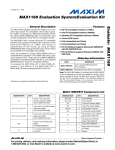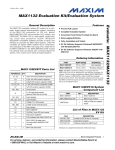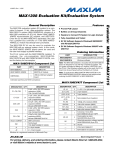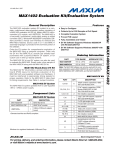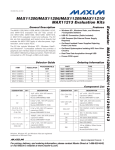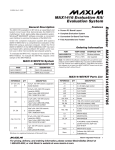Download Maxim USBTO232 User guide
Transcript
19-2582; Rev 1; 12/06 MAX1162 Evaluation System/Evaluation Kit The MAX1162 evaluation system (EV system) is a complete 16-bit data-acquisition system consisting of a MAX1162 evaluation kit (EV kit), Maxim 68HC16MODULE-DIP microcontroller (µC) module, and USBTO232. Order the complete EV system (MAX1162EVC16) for comprehensive evaluation of the MAX1162, using a personal computer (PC). Order the EV kit (MAX1162EVKIT) separately if the 68HC16MODULE-DIP module has already been purchased with a previous Maxim EV system or for custom use in other µC-based systems. This EV kit can also be used to evaluate the MAX1062 14-bit ADC. To evaluate the MAX1062, request a MAX1062AEUB free sample when ordering this EV kit. MAX1162 EV Kit Files PROGRAM Features ♦ Proven PCB Layout ♦ Convenient On-Board Test Points ♦ Fully Assembled and Tested ♦ EV Kit Software Supports Windows® 98/2000/XP with RS-232/COM Ports ♦ EV Kit Software Supports Windows 2000/XP with USB Ports Ordering Information PART TEMP RANGE INTERFACE MAX1162EVKIT 0°C to +70°C User supplied MAX1162EVC16 0°C to +70°C Windows software Note: The MAX1162 software is designed for use with the complete EV system. It includes both a µC module and the EV kit. If the Windows software will not be used, the EV kit board can be purchased by itself, without the µC module. FUNCTIONS MAX1162EVC16 System INSTALL.EXE Installs the EV kit files on your computer MAX1162.EXE Application program MAX1162EVKIT 1 MAX1162 EV kit KIT1162.C16 Software loaded into 68HC16 microcontroller 68HC16MODULE-DIP 1 68HC16 µC module USBTO232+ 1 USB-to-COM port adapter board PART QTY DESCRIPTION Component List DESIGNATION QTY C1, C4 2 10µF ±20%, 16V X5R ceramic capacitors (1210) TDK C3225X5R1C106M C2, C3, C5, C7, C8 5 0.1µF ±10%, 16V X7R ceramic capacitors (0603) TDK C1608X7R1C104KT C6 1 C9 1 DESCRIPTION DESIGNATION QTY DESCRIPTION TB0 1 2-circuit terminal block TP1 1 5-pin header U1 1 16-bit ADC (10-pin µMAX) MAX1162BCUB U2 1 Logic buffer (5-pin SOT23) Fairchild Semiconductor NC7SZ125 4.7µF ±20%, 16V X5R ceramic capacitor (1206) TDK C3216X5R1C475M U3 1 Op amp (5-pin SOT23) MAX4430EUK 4700pF ±10%, 50V X7R ceramic capacitor (0603) TDK C1603X7R1H472KT — 1 MAX1162 EV kit data sheet (includes 68HC16MODULE-DIP manual) — 1 PCB: MAX1162EVKIT FB1, FB2 2 Surface-mount ferrite beads (0603) TDK MMZ1608B601C — 1 3.5in software disk, MAX1162 evaluation kit J1 1 2 x 20 right-angle female connector — 1 MAX1162 data sheet R1 1 200Ω ±1% resistor (0603) Windows is a registered trademark of Microsoft Corp. ________________________________________________________________ Maxim Integrated Products For pricing, delivery, and ordering information, please contact Maxim/Dallas Direct! at 1-888-629-4642, or visit Maxim’s website at www.maxim-ic.com. 1 Evaluate: MAX1162/MAX1062 General Description Evaluate: MAX1162/MAX1062 MAX1162 Evaluation System/Evaluation Kit Component Suppliers SUPPLIER PHONE WEBSITE Fairchild Semiconductor 888-522-5372 www.fairchildsemi.com TDK Corp. 847-803-6100 www.component.tdk.com Note: Indicate that you are using the MAX1162 when contacting these component suppliers. Quick Start Recommended Equipment—USB Port PC Connection Option Before you begin, the following equipment is needed: • MAX1162EVC16 (MAX1162EVKIT 68HC16MODULE-DIP, and USBTO232) board, • Three DC power supplies: 8V to 20V, 5V, and -5V • External reference: +4.096V • Analog signal source: 0 to +4.096V • A PC running Windows 2000/XP with an available standard USB port to connect to the USBTO232 • USB cable included with the USBTO232 Procedure Caution: Do not turn on the power until all the connections are completed. 1) Visit the Maxim website (www.maxim-ic.com) to download the latest version of the USBTO232 User Guide. Follow the steps in the USBTO232 User Guide Quick Start section and return to step 2 of this Quick Start section when finished. 7) Apply a 4.096V reference voltage to the MAX1162 EV kit’s terminal block (TB0) located in the upperleft corner of the MAX1162 EV kit board. Observe the polarity marked on the board. 8) Connect the USBTO232 board to the 68HC16MODULE-DIP module if you have not done so already. 9) The MAX1162 EV kit software should have already been downloaded and installed in the USBTO232 Quick Start. 10) Start the MAX1162 program by opening its icon in the Start | Programs menu. 11) Turn on all power supplies and enable the reference voltage. Slide SW1 to the ON position on the 68HC16MODULE-DIP module. Press the OK button to automatically connect and download the KIT1162.C16 file to the module. 12) Apply an input signal (0V to VREF) between AIN and GND. Observe the readout on the running Windows program. Recommended Equipment—RS-232/COM Port PC Connection Option Before you begin, the following equipment is needed: 2) Carefully connect the boards by aligning the 40-pin connector of the MAX1162 EV kit with the 40-pin header of the 68HC16MODULE-DIP module. Gently press them together. The two boards should be flush against one another. • MAX1162EVC16 (MAX1162EVKIT board and 68HC16MODULE-DIP) • Three DC power supplies: 8V to 20V, 5V, and -5V • External reference: +4.096V 3) Ensure that the 68HC16MODULE-DIP module’s SW1 switch is in the OFF position. • Analog signal source: 0 to +4.096V • 4) Connect the 8V to 20V power supply to the 68HC16MODULE-DIP module’s terminal block (J2) located next to SW1. Observe the polarity marked on the board. A PC running Windows 98/2000/XP with an available standard serial port, preferably a 9-pin plug • A standard serial cable to connect the PC’s standard serial port to the 68HC16MODULE-DIP module 5) Connect the 5V power supply to the VDD pad (with respect to the GND pad) on the MAX1162 EV kit board. Caution: Do not turn on the power until all the connections are completed. 6) Connect the -5V power supply to the VEE pad (with respect to the GND pad) on the MAX1162 EV kit board. 1) Visit the Maxim website (www.maxim-ic.com/evkitsoftware) to download the latest version of the EV kit software. Save the EV kit software to a temporary folder and uncompress the file (if it is a .zip file). 2 Procedure _______________________________________________________________________________________ MAX1162 Evaluation System/Evaluation Kit 3) Carefully connect the boards by aligning the 40-pin connector of the MAX1162 EV kit with the 40-pin header of the 68HC16MODULE-DIP module. Gently press them together. The two boards should be flush against one another. 4) Ensure that the 68HC16MODULE-DIP module’s SW1 switch is in the OFF position. 5) Connect the 8V to 20V power supply to the 68HC16MODULE-DIP module’s terminal block (J2) located next to SW1. Observe the polarity marked on the board. 6) Connect the 5V power supply to the VDD pad (with respect to the GND pad) on the MAX1162 EV kit board. 7) Connect the -5V power supply to the VEE pad (with respect to the GND pad) on the MAX1162 EV kit board. 8) Apply a 4.096V reference voltage to the MAX1162 EV kit’s terminal block (TB0) located in the upperleft corner of the MAX1162 EV kit board. Observe the polarity marked on the board. 9) Connect a standard serial cable from the computer’s serial port to the 68HC16MODULE-DIP module. If the PC’s standard serial port has a 9-pin connector, use a straight-through, 9-pin female-to-male cable. If the PC’s only available standard serial port has a 25-pin connector, a standard 25-pin to 9-pin adapter is required. The EV kit software checks the modem status lines (CTS, DSR, DCD) to confirm that the correct port has been selected. 10) Start the MAX1162 program by opening its icon in the Start | Programs menu. 11) Turn on all power supplies and enable the reference voltage. Slide SW1 to the ON position on the 68HC16MODULE-DIP module. Press the OK button to automatically connect and download the KIT1162.C16 file to the module. 12) Apply an input signal (0V to VREF) between AIN and GND. Observe the readout on the running Windows program. Detailed Description MAX1162 Stand-Alone EV Kit The MAX1162 EV kit provides a proven PCB layout to evaluate the MAX1162. It must be interfaced to appropriate timing signals for proper operation. Connect 5V to VDD and -5V to VEE with respect to GND. Apply a 4.096V reference voltage to the MAX1162 EV kit’s terminal block (TB0) located in the upper-left corner of the MAX1162 EV kit board. See the MAX1162 EV Kit Schematic (Figure 2) and refer to the MAX1162 data sheet for timing requirements. MAX1162 EV System The MAX1162EVC16 EV system operates from three user-supplied power supplies: 8V to 20V, 5V, and -5V. Connect the 8V to 20V power supply to the µC module’s terminal block (J2) located next to SW1. Observe the polarity marked on the board. Connect 5V to VDD and -5V to VEE with respect to GND on the MAX1162 EV kit board. Apply a 4.096V reference voltage to the MAX1162 EV kit’s terminal block (TB0) located in the upper left corner of the MAX1162 EV kit board. See the MAX1162 EV Kit Schematic (Figure 2). Windows 98/2000/XP-compatible software interfaces to the EV system board through the PC’s standard serial port (virtual COM port). See the Quick Start section for complete setup and operating instructions. Detailed Description of Software The EV software’s main window is shown in Figure 1. It controls the serial clock speed and sample rate. It also displays the voltage and output code as well as some statistics of the input signal. A separate graph shows the data changing in real time. The update rate is limited to about 10 samples per second, due to COM port bandwidth limitations. Sample Rate The SPI SCLK Frequency area allows the user to vary the ADC to µC sample rate. The PC is not capable of retrieving the data that was stored in the memory of the µC as fast as the µC can obtain the data from the ADC. This is because the µC’s SPI interface is much faster than the PC’s standard serial port (virtual COM port). Hence, the ADC to µC sample rate refers to the sample _______________________________________________________________________________________ 3 Evaluate: MAX1162/MAX1062 2) Install the MAX1162 EV kit software on your computer by running the INSTALL.EXE program. The program files are copied and icons are created for them in the Windows Start | Programs menu. Evaluate: MAX1162/MAX1062 MAX1162 Evaluation System/Evaluation Kit rate at which data is being sampled by the ADC and stored in the µC’s memory. Use the pulldown menu to select the desired SCLK frequency. The first two digits are the divisor for the µC’s internal clock. The next floating point number is the corresponding SCLK frequency. The ADC to µC sample rate is displayed in the ADC to µC sample rate field located on the right side of the main window. The µC to PC transfer rate is controlled using the field at the bottom of the main window and can be controlled in two different ways. Pressing the Read button allows the user to manually grab a sample from the µC’s memory. Clicking the Read Every checkbox allows the user to automatically read samples from the µC’s memory at a rate selectable in milliseconds. To retrieve a block of consecutively sampled data to the PC, click on the Sample menu located at the top left-hand corner of the main window. The data-block length is selectable and the data can be saved to a file. Statistics The Minimum and Maximum fields in the statistics area show the highest and lowest readings acquired. The Average field displays a running mean. When reading data manually by pressing the Read button, the Average and RMS fields require approximately five samples until they are accurately represented. The Clear Statistics button resets the statistics. To remove offset errors, first apply zero volts to the active input channel, press the Clear Statistics button, acquire some samples, and then check the Null Offset checkbox. Once checked, the label next to the Null Offset checkbox shows the sampled offset error. This value is subtracted from all subsequent measurements until the checkbox is unchecked. 4 Reference Voltage The EV software assumes a 4.096V reference voltage, unless otherwise specified. To override the 4.096V reference value, apply the new reference voltage at the terminal block (TB0) on the MAX1162 EV kit board, type in the new reference voltage, without the volt unit, and press the Set Vref button. The EV kit software uses the value typed in the VREF field to translate the digital code to a voltage. Detailed Description of Hardware The MAX1162 is a 16-bit serial ADC. When the MAX1162 EV kit board is connected to the 68HC16MODULE-DIP module, power is provided to U2 by the module. The user must also provide 5V to VDD and -5V to VEE (with respect to the GND pads) on the MAX1162 EV kit board. The MAX1162 EV kit contains two different types of buffers. U2 is a logic buffer to limit the load capacitance that is seen by the DOUT line of the MAX1162. U1 is powered from VDD. U3 is powered from VDD and VEE. A terminal block (TB0) has also been provided on the MAX1162 EV kit board for the external reference. See the Reference Voltage section and the MAX1162 EV Kit Schematic (Figure 2). _______________________________________________________________________________________ MAX1162 Evaluation System/Evaluation Kit Evaluate: MAX1162/MAX1062 Note: The MAX1162 evaluation software’s main window controls the MAX1162 and displays conversion results. Figure 1. MAX1162 EV Software’s Main Window _______________________________________________________________________________________ 5 Evaluate: MAX1162/MAX1062 MAX1162 Evaluation System/Evaluation Kit AVDD DVDD FB1 VDD C1 10µF GND C2 0.1µF C3 0.1µF FERRITE C4 10µF TP1 TP1-1 TP1-2 AIN 3 IN+ OUT IN- 1 4 R1 200Ω 1% TBO U3 GND VEE GND 8 AVDD DVDD UCVDD AIN C9 4700pF TERMINAL BLOCK 1 J1-38 10 CS U1 REF VCC DOUT TP1-5 5 C5 0.1µF TP1-4 TEST POINT U2 NC7SZ125 5 6 TP1-3 DVDD J1-37 SCLK C6 4.7µF OE 4 MAX1162 1 TBO-1 MAX4430 2 J1 J1-1 2 A J1-2 2 VEE VCC 5 C7 0.1µF TBO-2 AGND AGND DGND C8 0.1µF 3 9 7 FB2 J1-35 3 GND Y J1-3 4 FERRITE J1-4 UCVDD J1-7 J1-8 Figure 2. MAX1162 EV Kit Schematic 6 _______________________________________________________________________________________ MAX1162 Evaluation System/Evaluation Kit Figure 4. MAX1162 EV Kit PCB Layout—Component Side Figure 5. MAX1162 EV Kit PCB Layout—Inner Layer 2 (GND) Figure 6. MAX1162 EV Kit PCB Layout—Inner Layer 3 (VDD) _______________________________________________________________________________________ Evaluate: MAX1162/MAX1062 Figure 3. MAX1162 EV Kit Component Placement Guide— Component Side 7 Evaluate: MAX1162/MAX1062 MAX1162 Evaluation System/Evaluation Kit Figure 7. MAX1162 EV Kit PCB Layout—Solder Side Figure 8. MAX1162 EV Kit Component Placement Guide— Solder Side Revision History Pages changed at Rev 1: 1–8 Maxim cannot assume responsibility for use of any circuitry other than circuitry entirely embodied in a Maxim product. No circuit patent licenses are implied. Maxim reserves the right to change the circuitry and specifications without notice at any time. 8 _____________________Maxim Integrated Products, 120 San Gabriel Drive, Sunnyvale, CA 94086 408-737-7600 © 2006 Maxim Integrated Products is a registered trademark of Maxim Integrated Products, Inc.








